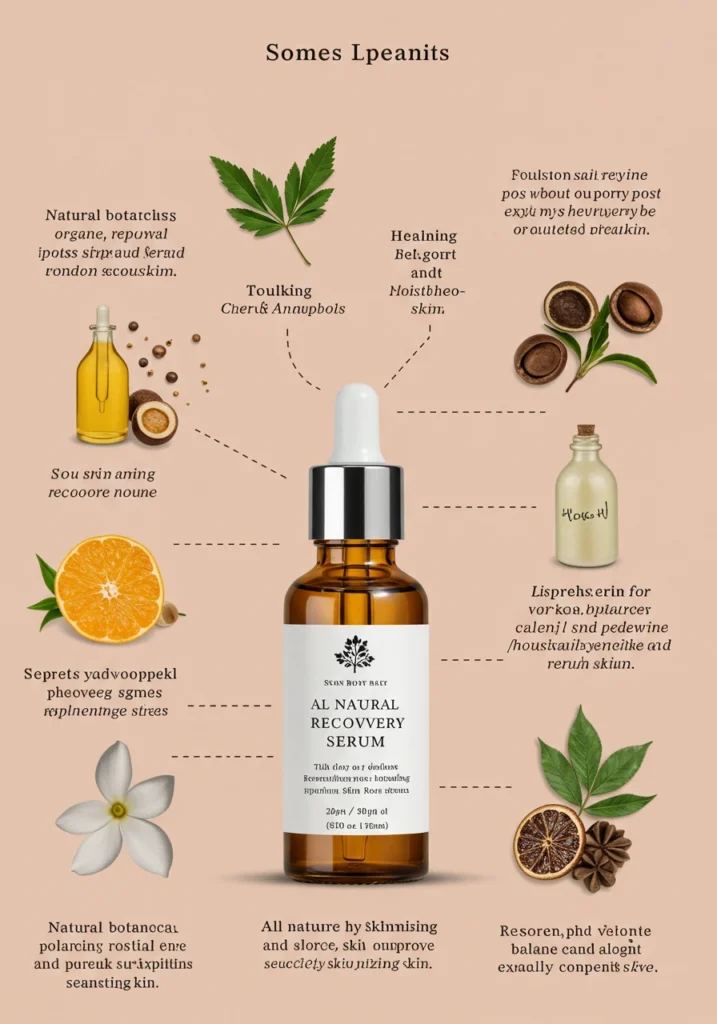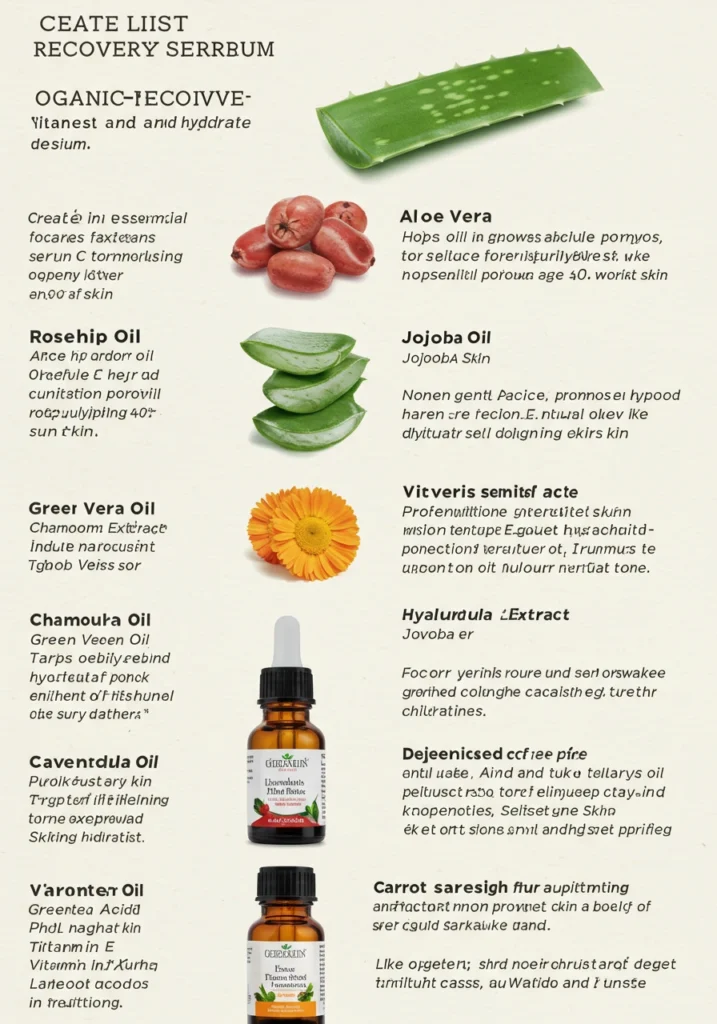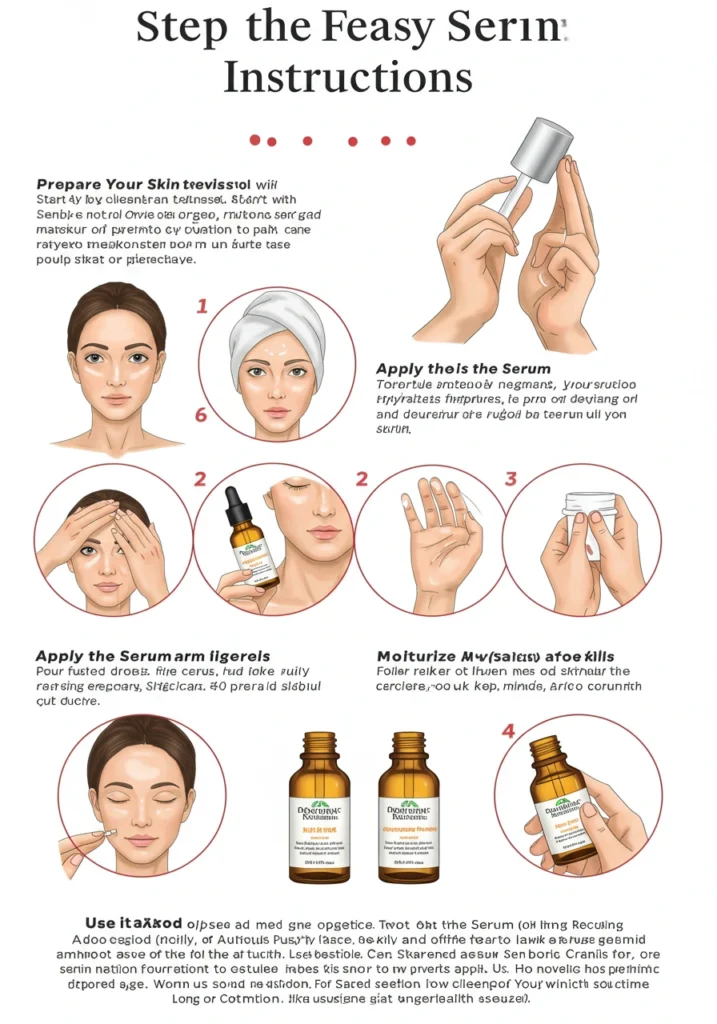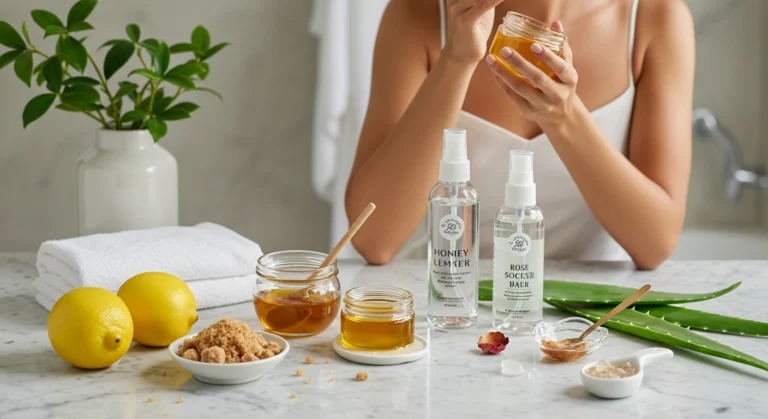Table of Contents
Frustrated with skin that looks tired, stressed, and prematurely aged despite trying countless products? You’re not alone. Environmental damage, stress, and harsh skincare ingredients can leave even the most diligent of us with skin that looks dull, uneven, and lacks resilience.
An organic recovery serum could be the game-changer your skin has been waiting for. Unlike conventional serums loaded with synthetic ingredients, a properly formulated organic recovery serum works with your skin’s natural processes to repair damage, restore balance, and revitalize your complexion from within.
As someone who spent over a decade battling inflammatory skin conditions and premature aging concerns, I’ve researched, tested, and formulated countless serums. Through this journey, I discovered that organic recovery serums delivered the most transformative results for my skin and thousands of my readers. The secret lies not just in what these serums contain, but also in how they’re used.
In this comprehensive guide, you’ll discover the science behind organic recovery serums, the six essential tips for maximizing their effectiveness, key ingredients to look for (and avoid), step-by-step application instructions, and expert recommendations for different skin types. Whether you’re new to organic skincare or looking to enhance your current routine, these evidence-based insights will help you achieve healthier, more radiant skin.
Why Organic Recovery Serums Work

Organic recovery serums aren’t just a trending buzzword—they represent a fundamentally different approach to skin repair and rejuvenation that delivers remarkable results:
- Biocompatibility: Formulated with plant-based ingredients that your skin recognizes and can utilize effectively without triggering inflammatory responses
- Concentrated nutrient delivery: Provides a potent dose of antioxidants, fatty acids, and phytonutrients that support your skin’s natural repair mechanisms
- Cumulative benefits: Unlike synthetic quick-fixes that may show immediate results but cause long-term damage, organic serums build skin health progressively
- Environmentally sustainable: Production methods preserve the potency of ingredients while minimizing ecological impact
- Holistic skin support: Addresses multiple concerns simultaneously rather than targeting only one aspect of skin health
The 6 Essential Tips for Organic Recovery Serum Success
Tip 1: Choose Truly Organic Formulations
Not all products labeled “organic” deliver the same benefits. For maximum effectiveness:
- Look for legitimate certifications (USDA Organic, COSMOS, Ecocert)
- Verify that key active ingredients (not just fillers) are organic
- Avoid “greenwashed” products with only one or two organic ingredients
- Check manufacturing methods—cold-pressed and unrefined ingredients retain more nutrients
Tip 2: Match Ingredients to Your Specific Concerns
The most effective organic recovery serum for you depends on your unique skin concerns:
- For fine lines and loss of firmness: Look for peptide-rich plant extracts like hibiscus and blue tansy
- For hyperpigmentation and uneven tone: Seek vitamin C-rich ingredients like sea buckthorn and kakadu plum
- For sensitivity and redness: Prioritize anti-inflammatory botanicals like calendula and chamomile
- For dehydration and rough texture: Focus on hyaluronic acid-boosting herbs and aloe vera
Tip 3: Layer Products Strategically
How you incorporate your organic recovery serum affects its efficacy:
- Apply to slightly damp skin to enhance absorption
- Layer from thinnest to thickest consistency
- Allow 30-60 seconds between products
- Consider the “moisture sandwich” technique for enhanced hydration
- Use gentle pressing motions rather than rubbing
Tip 4: Time Your Application Strategically
Different organic recovery serums work best at specific times:
- Antioxidant-rich formulas provide protection during daytime
- Repair-focused blends accelerate recovery during sleep
- Hydration-centered options can be used twice daily
- Consider seasonal adjustments based on environmental exposure
Tip 5: Prioritize Consistency Over Quantity
With organic recovery serums, less is often more:
- Start with a few drops, increasing gradually if needed
- Use consistently rather than sporadically at higher doses
- Allow 2-4 weeks for visible results (cell turnover cycle)
- Document your progress with photos to track improvements
- Avoid overloading skin with too many active ingredients
Tip 6: Store and Preserve Properly
Organic ingredients require proper care to maintain potency:
- Keep in cool, dark places away from direct sunlight
- Use dark glass containers that protect light-sensitive compounds
- Consider refrigeration for certain ingredients (especially vitamin C formulations)
- Note shelf life once opened (typically 3-6 months)
- Look for airless pump packaging to minimize oxidation
Choosing the Right Ingredients

H3: Top Ingredients for Skin Renewal
For Cellular Repair and Renewal:
- Sea Buckthorn Oil: Rich in rare omega-7 fatty acids that support cell membrane health and repair
- Rosehip Seed Oil: Contains natural retinol alternatives (trans-retinoic acid) for gentle cellular turnover
- Bakuchiol: Plant-derived retinol alternative that stimulates collagen without irritation
- Blue Tansy: Provides azulene compounds that reduce inflammation while promoting repair
For Deep Hydration and Barrier Support:
- Hyaluronic Acid: Plant-derived versions from fermented wheat or corn provide multi-level hydration
- Squalane: Olive-derived squalane mimics skin’s natural sebum for balanced moisture
- Evening Primrose Oil: Supplies gamma-linolenic acid that strengthens compromised barriers
- Aloe Vera: Offers 200+ bioactive compounds that hydrate while delivering nutrients
For Brightening and Evening Tone:
- Vitamin C: From sources like kakadu plum, acerola cherry, and amla berry
- Licorice Root Extract: Contains glabridin that inhibits melanin production
- Hibiscus: Provides gentle alpha-hydroxy acids for surface exfoliation
- Green Tea: Rich in EGCG that regulates pigmentation while providing antioxidant protection
H3: What to Avoid
Synthetic Stabilizers and Preservatives:
- Parabens (methylparaben, propylparaben)
- Phenoxyethanol
- BHA/BHT
- Formaldehyde-releasing preservatives
Potential Irritants:
- Synthetic fragrance (listed as “parfum” or “fragrance”)
- Essential oils in high concentrations (especially citrus)
- Alcohol denat (denatured alcohol)
- Sulfates and harsh detergents
Environmentally Problematic Ingredients:
- Microplastics and synthetic polymers
- Petrochemical derivatives
- Non-sustainable palm oil derivatives
- Ingredients with poor biodegradability
H3: Beneficial Substitutions
For Synthetic Emulsifiers:
- Lecithin from sunflower or soy
- Plant-derived glycerin
- Vegetable-based emulsifying waxes
- Quillaja bark extract
For Commercial Preservatives:
- Radish root ferment filtrate (Leuconostoc)
- Lactobacillus ferment
- Honeysuckle extract
- Neem oil in small percentages
For Artificial Thickeners:
- Xanthan gum from fermentation
- Algin from seaweed
- Irish moss extract
- Guar gum from guar beans
DIY Organic Recovery Serum Recipe
H3: Prep Essentials
Before creating your organic recovery serum:
- Sanitize Equipment: Sterilize all containers, droppers, and utensils with boiling water or food-grade alcohol.
- Prepare Workspace: Clean your preparation area thoroughly to prevent contamination.
- Quality Sourcing: Use only high-quality, organic, cold-pressed carrier oils and pure essential oils.
- Patch Test Components: Test individual ingredients on your inner arm for 24 hours before combining.
- Precision Matters: Use small digital scales or precise droppers for accurate measurements.
H3: Core Ingredients List
Base Oils (2 tablespoons total, mixed to suit your skin type):
- 1 tablespoon organic jojoba oil (balancing for all skin types)
- 1 teaspoon organic rosehip seed oil (regenerative and rich in vitamin A)
- 1 teaspoon organic sea buckthorn oil (healing and rich in omega-7)
- 1 teaspoon organic evening primrose oil (anti-inflammatory)
Active Botanical Extracts (15-20 drops total):
- 5 drops vitamin E oil (preservative and antioxidant)
- 5 drops helichrysum essential oil (regenerative)
- 5 drops frankincense essential oil (promotes cell health)
- 3 drops lavender essential oil (balancing and calming)
- 2 drops carrot seed essential oil (rejuvenating)
Additional Enhancement (optional):
- ¼ teaspoon organic aloe vera gel (for increased hydration)
- 3 drops CoQ10 oil (for enhanced antioxidant protection)
- 2 drops licorice root extract (for brightening)
H3: Simple Supplies
Essential Tools:
- Dark amber or cobalt blue glass bottle with dropper (1 oz/30ml size)
- Small glass measuring cups or beakers
- Glass stirring rod or stainless steel mini whisk
- Small funnel
- Labels and marker for dating your creation
- Small digital scale (if available)
Step-by-Step Application Instructions

1. Before You Begin
Prepare your skin to maximize absorption and benefits:
- Cleanse thoroughly with a gentle, pH-balanced cleanser that won’t strip natural oils.
- Optional steam by holding face over a bowl of hot water (not boiling) with a towel over your head for 1-2 minutes to open pores.
- Tone skin with alcohol-free witch hazel or rose water to balance pH.
- Pat skin until just slightly damp – not completely dry or dripping wet.
- Perform patch test if using the serum for the first time by applying a small amount behind your ear or on inner wrist.
2. How to Apply
For optimal absorption and effectiveness:
- Dispense 3-5 drops of your organic recovery serum into your palm.
- Warm the serum by gently rubbing palms together for 3-5 seconds.
- Press gently into skin using upward motions, starting from the center of your face outward.
- Pay special attention to areas of concern (fine lines, hyperpigmentation, etc.).
- Use ring fingers for the delicate under-eye area, avoiding direct contact with eyes.
- Allow 60 seconds for initial absorption before proceeding to the next step in your routine.
3. Aftercare & Follow-up
Complete your routine for maximum benefits:
- Follow with moisturizer to seal in the serum’s active ingredients (wait 60 seconds first).
- Apply sunscreen if using during daytime, even if the serum contains antioxidants.
- Consider facial massage with gua sha or facial roller to enhance penetration.
- Avoid touching face after application to prevent transferring bacteria.
- Document results with weekly photos in consistent lighting to track improvements.
Pro Tips for Radiant Results
H3: Avoiding Irritation
- Start slowly: Begin with application every other day until skin acclimates.
- Dilution strategy: Mix with a drop of your regular moisturizer initially if sensitivity occurs.
- Avoid active conflicts: Don’t use other active ingredients like AHAs/BHAs, retinol, or vitamin C simultaneously when first starting.
- Pay attention to essential oil content: Keep total essential oil concentration under 2% (about 12 drops per ounce of carrier oil).
- Heed warning signs: Discontinue if persistent redness, stinging, or rash develops.
H3: Application Techniques
- Facial mapping: Apply more serum to drier areas, less to oily zones.
- Temperature enhancement: Slightly warm serum between palms before applying.
- Lymphatic application: Use gentle upward and outward motions following lymph drainage pathways.
- Breathing technique: Practice deep breathing during application to enhance relaxation benefits.
- Pressure points: Spend 3-5 seconds pressing on key facial pressure points during application.
H3: Storage & Preservation
- Refrigeration benefits: Store your organic recovery serum in the refrigerator to extend shelf life and provide a cooling sensation during application.
- Oxygen exposure: Always close the bottle tightly immediately after use.
- Light protection: Keep in dark glass bottles and store away from direct sunlight.
- Contamination prevention: Never touch the dropper directly to your skin.
- Freshness tracking: Label your bottle with the creation date and discard after 3 months.
Custom Variations
H3: For Mature Skin & Anti-Aging Focus
- Enhance with: Additional rosehip seed oil (2 extra drops per application)
- Add: 2 drops of pomegranate seed oil for its powerful antioxidant properties
- Include: Frankincense essential oil (2 drops) for its cell-regenerating properties
- Consider: CoQ10 supplement oil (2 drops) to support cellular energy production
- Boosted application: Use with facial massage focusing on expression lines
H3: For Acne-Prone Skin
- Base adjustment: Increase jojoba oil percentage (up to 70% of carrier oil blend)
- Add: 2 drops of tamanu oil for its extraordinary healing properties
- Include: Tea tree essential oil (1-2 drops maximum) for antimicrobial benefits
- Consider: Black cumin seed oil (2-3 drops) for its balancing effect
- Application focus: Use light, gentle pressing rather than massage which may irritate active breakouts
H3: For Hypersensitive Skin
- Base adjustment: Add 1/4 teaspoon of organic aloe vera gel for additional soothing
- Remove: All potentially stimulating essential oils
- Replace with: German chamomile oil (2 drops) and calendula-infused oil (1 teaspoon)
- Add: 2 drops of blue tansy essential oil for anti-inflammatory benefits
- Application adaptation: Apply over a light mist of thermal spring water for buffering
Best Times to Use Organic Recovery Serum
Morning Application Benefits
Using your organic recovery serum in the morning provides:
- Antioxidant shield against environmental pollutants and UV radiation
- Hydration foundation that prepares skin for makeup application
- All-day nourishment as ingredients slowly absorb and work throughout the day
- Immediate radiance boost from the natural oils’ light-reflecting properties
Pro tip: Allow 5-10 minutes before applying sunscreen and makeup for optimal absorption.
Evening Recovery Potential
Nighttime application maximizes:
- Cellular repair processes that naturally increase during sleep
- Enhanced absorption due to higher skin temperature at night
- Undisturbed treatment time for 6-8 hours without environmental exposure
- Compatibility with skin’s natural regeneration cycle
Pro tip: Apply 30 minutes before bedtime to prevent transfer to pillowcases.
Intensive Treatment Periods
Consider increased frequency during:
- Seasonal transitions when skin is adapting to temperature and humidity changes
- After sun exposure to calm inflammation and replenish moisture
- During periods of high stress when cortisol can compromise skin barrier function
- Following professional treatments like microdermabrasion or chemical peels
Pro tip: Double your application frequency but use half the amount per application.
FAQs
Is organic recovery serum suitable for sensitive skin?
Yes, but with careful ingredient selection. Look for serums with minimal essential oils, no citrus oils, and calming ingredients like chamomile and calendula. Always patch test, and consider formulations specifically labeled for sensitive skin. Our DIY version can be adapted by omitting potentially stimulating ingredients.
How often should I apply organic recovery serum?
For most skin types, daily application is ideal—either morning or evening based on your skin’s needs and the serum’s specific formulation. Those with very dry skin may benefit from twice-daily application, while sensitive skin might do better with every-other-day use initially. Listen to your skin and adjust accordingly.
Can I combine organic recovery serum with other skincare products?
Yes, with strategic layering. Apply after cleansing and toning but before heavier creams and oils. Avoid using simultaneously with potentially conflicting ingredients like synthetic retinoids or high-percentage AHAs. Allow 15-30 minutes between applying your serum and these active ingredients if you do use both in your routine.
How long before I see results from organic recovery serum?
Initial hydration benefits and luminosity appear within days, but more significant improvements in texture, tone, and resilience typically emerge after 4-6 weeks of consistent use (one complete skin cell turnover cycle). For concerns like hyperpigmentation or deep wrinkles, expect gradual improvement over 2-3 months.
Will organic recovery serum clog my pores?
Well-formulated organic recovery serums should be non-comedogenic. Look for lightweight oils like jojoba, grapeseed, and squalane as bases rather than heavier butters or coconut oil if you’re prone to congestion. The proper ratio of astringent to emollient ingredients will provide balance without clogging pores.
Does organic recovery serum replace moisturizer?
For very oily skin types, a well-formulated organic recovery serum might provide sufficient hydration alone. However, most skin types benefit from following serum with an appropriate moisturizer to seal in active ingredients and provide additional barrier support. Consider your serum as the treatment step and moisturizer as the protection step.
Conclusion
Incorporating an organic recovery serum into your skincare routine represents one of the most impactful changes you can make for long-term skin health. Unlike conventional products that may deliver quick but superficial results, these plant-powered formulations work at a deeper level, addressing the root causes of skin concerns while supporting your skin’s inherent wisdom.
The six essential tips we’ve explored—choosing truly organic formulations, matching ingredients to your concerns, strategic layering, timing application optimally, maintaining consistency, and proper storage—create a framework for success that transcends trendy ingredients or marketing promises.
What’s particularly remarkable about organic recovery serums is their ability to adapt to your skin’s changing needs. Rather than forcing specific outcomes through harsh synthetic ingredients, they provide the nutritional building blocks your skin requires to find its own balance and radiance.
Thousands of my readers have experienced transformative results by switching to organic recovery serums, reporting not just improved appearance but healthier skin that’s more resilient to stress and environmental challenges. As one reader shared, “After years of chasing quick fixes, my skin finally feels like it’s healing from within.”
Ready to explore more natural skincare solutions? Discover our [Complete Guide to Facial Oils] or learn about [Natural Ingredients for Hyperpigmentation] to complement your organic recovery serum routine.
Your skin’s natural radiance awaits—nourish it mindfully and consistently with the power of organic recovery







